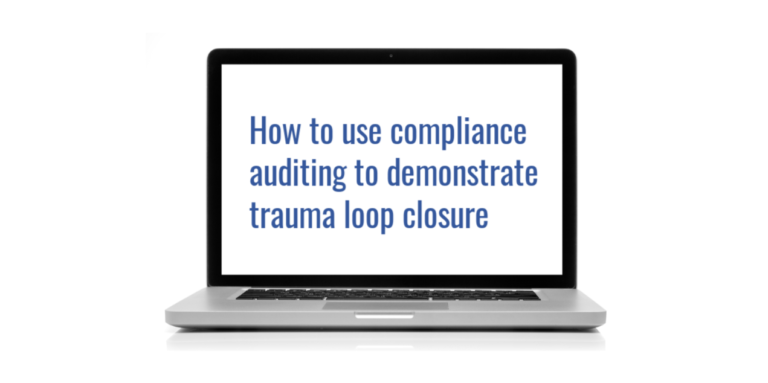The heart of trauma loop closure is corrective action. Trauma program leaders need to take concrete steps to ensure a past quality problem is less likely to affect future patients. However, action alone is not enough. To truly close the loop on an identified event, you need to demonstrate that corrective actions have been effective.
How do you demonstrate the effectiveness of a performance improvement (PI) action plan? According to the Orange Book, the key is ongoing monitoring: “Effective performance improvement demonstrates that a corrective action has had the desired effect as determined by continuous monitoring and evaluation.”
Based on my work with trauma centers nationwide, many program managers and PI coordinators are unsure how to put this concept into practice. In this article, I will show how to demonstrate the effectiveness of a corrective action plan using compliance auditing.
A strong compliance auditing plan is essential to documenting event resolution. It can also energize the loop closure process itself by helping trauma leaders identify hidden problems that lead to low-quality care and suboptimal patient outcomes.
Scenario: Failure to document initial ED temperature
To understand the role of compliance monitoring in loop closure, let’s walk through a typical quality improvement scenario. During a chart review, a PI coordinator discovers that ED staff are not consistently documenting initial hospital temperature for injured patients. This might seem like an innocuous omission, but failure to maintain patient temperature can be lethal. Therefore it is critical that nurses capture a baseline reading for all trauma patients.

After validating the opportunity and reviewing the data, the issue is eventually escalated to tertiary review. Ultimately, the team develops an education-based corrective action plan: ED nursing staff receive refresher training on the importance of assessing and documenting temperature for all trauma patients.
Many trauma leadership teams would stop there. After all, they have taken action to address a root cause of the problem, right?
But here is the key question: How do we know we have prevented this problem from recurring? In other words, how can we prove that our corrective actions were truly effective?
The only way to prove the effectiveness of a corrective action plan is to measure its outcomes. National trauma quality organizations recommend an approach that incorporates benchmarking and data tracking:
- For example, the Trauma Outcomes & Performance Improvement Course® (TOPIC®) recommends that event resolution should include monitoring for repeat events, monitoring compliance rates against benchmarks, and tracking and trending data.
- This concept is also built into the Orange Book. According to CD 16-2, “Problem resolution, outcome improvements, and assurance of safety (‘loop closure’) must be readily identifiable through methods of monitoring, reevaluation, benchmarking, and documentation”.
Compliance monitoring is very manageable if you break it down into steps. The following approach has been adopted by several high-performing trauma programs:
1. Determine the appropriate compliance threshold
The first step is to establish how you will define and evaluate compliance for the quality issue you are addressing. There are several ways to determine an appropriate compliance target:
- If there is an existing industry standard for a care process or patient outcome, use that standard to define your benchmark. For example, if you are trying to ensure timely surgical intervention for patients with open fracture, use the 24-hour “time to OR” recommendation specified by the Trauma Quality Improvement Program (TQIP).
- If no industry benchmark exists, find out whether your hospital has an internal quality standard that can be applied. Alternatively, determine where another evidence-based benchmark exists in the literature.
- If no standards or evidence-based benchmarks exist, the best course is simply to establish an acceptable improvement target. One caveat: If your program’s current compliance rate for a given process is low (for example, 25%), it might make sense to aim for an intermediate goal (say, 50%) before targeting high compliance.
In the ED temperature scenario described above, program leaders are not able to identify a published benchmark. Since the ED’s current compliance with temperature documentation is around 70%, the trauma program adopts a compliance target of 95%.
2. Audit charts for compliance fall-outs
Once your measurement plan is in place, create an audit filter and start reviewing all trauma activations for compliance. The key to success is to involve other team members in the audit process.

3. Identify opportunities to improve performance
Fall-outs identified during chart review point to potential holes in your corrective action plan.
Some compliance lapses will represent provider issues, and these can be addressed individually. The first step is direct feedback, but staff members who continuously fall short on an important best practice should be removed from the trauma team. (In a case like this, documentation of trauma staffing decisions will be part of loop closure).
Fall-outs can also indicate system issues. The key is whether or not any “common themes” emerge. If a shortfall represents a unique circumstance, there may be no opportunity for improvement. But if several fall-outs involve a common factor, there may be an opportunity to improve results by adjusting the system. For instance, if several ED documentation failures were caused by computer downtime, it makes sense to address computer reliability issues as part of a PI initiative.
This process can continue even after a team has achieved a compliance target. For example, if ED temperature documentation has reached the 95% compliance rate, the remaining 5% of fall-outs can still provide opportunities to learn and improve.
4. Review scorecards at monthly system meetings
Track and report ongoing results using a PI scorecard that expresses compliance in terms of a numerator and a denominator. In our scenario, the numerator would be trauma activations with a documented ED temperature and the denominator would be all trauma activations.
I recommend presenting PI scorecards at the monthly meeting of the multidisciplinary trauma peer review committee or the trauma systems/operations committee. This creates the opportunity to ask other department leaders for help resolving persistent quality issues.
For example, your program is tracking “time to CT” for head injury patients. You have instituted corrective actions and are making progress, but there are still logistical issues with radiology that are causing friction. Sharing your PI scorecard during a multidisciplinary meeting will help trauma, ED and radiology leaders identify the obstacles and adjust processes accordingly.
5. Monitor compliance to ensure sustained improvement
How long should compliance auditing continue for a PI issue? There is no hard and fast rule, but the first step is to consult your organization’s quality standards for guidance.
Typically, you should continue to audit PI compliance until your team has maintained the target compliance rate for 3 consecutive months. Bear in mind that the entire process will usually take longer, because it may take several months to attain initial compliance and then maintain it for a full quarter.
If at any point you determine that compliance is slipping, restart the audit process. Additional audit-feedback-monitor cycles will help ensure a performance improvement is durable, not just a transient effect.
A key part of the improvement cycle
No trauma program will ever be without opportunities to improve — and that is a good thing. Trauma sets the standard for PI throughout most hospitals, and our dedication to the continuous improvement cycle helps ensure high-quality care for all patients.
Compliance auditing is a key part of the PI cycle. It is essential to documenting a corrective action plan for an identified event. And ongoing monitoring creates “guardrails” to prevent or mitigate a repeat occurrence.
Angie Chisolm, MBA, BSN, RN, CFRN, TCRN is a nationally recognized expert in trauma program operational efficiency, coding and billing, site survey readiness and performance improvement. Angie is also president and managing partner of Optimal Healthcare Advisors.

